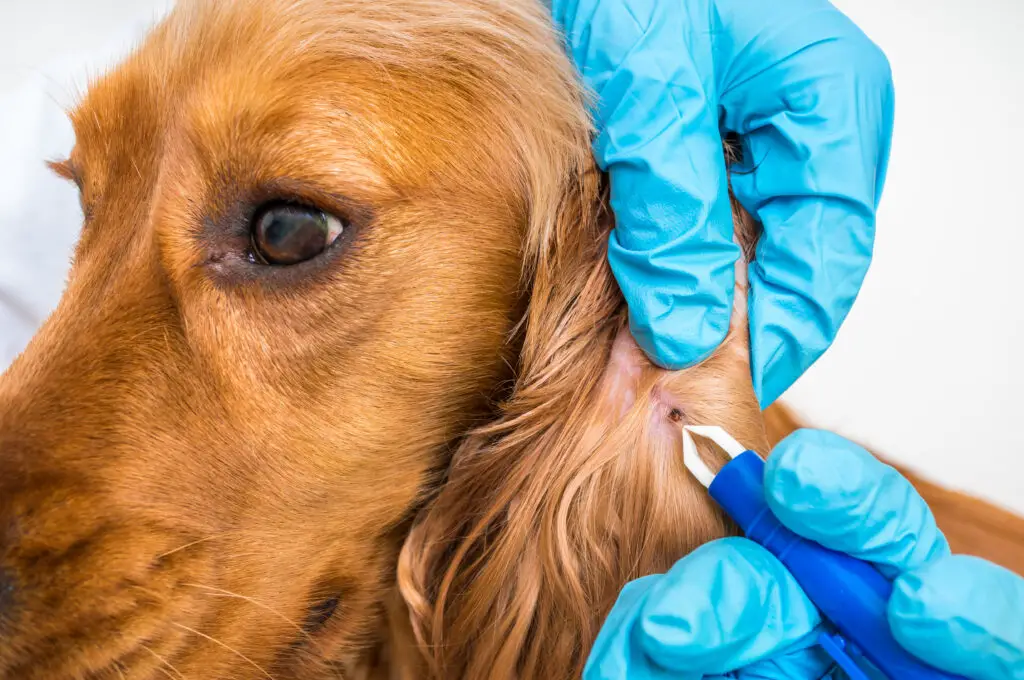Our website is supported by our users. We sometimes earn money when you click an affiliate link and make a purchase. This is at no extra cost to you and helps us to create quality content. Thank you for your support. For all that have shown us such wonderful support, we thank you from the bottom of our hearts!
Dogs like to go on “sniffy” walks and adventures into the woods with their owners. Likewise, owners like to take their furry friend to explore new areas and hike off the beaten path.
Unfortunately, in many parts of the country dogs and humans pick up eight legged hitchhikers, called ticks. Ticks are a type of arachnid that thrive in wooded areas, beaches, tall grasses, forests, and marshy urban environments.
There are 700 species of hard ticks and 200 species of soft ticks that live in the United States. All dogs and dog owners do not want these little vampires on them taking a blood meal.

In this article, How to Remove a Dried Dead Tick on Dog, you will learn the following:
· Tick Habitat and Infestations
· Understanding the Life Cycle of a Tick
· How to Identify Common Ticks
· Safety Tips for Removing a Dried Dead Tick
· Signs and Symptoms of Tick-Borne Disease
· First Aid After Removing a Dried Dead Tick on Dog
Dried Dead Tick on Dog: Tick Habitat and Infestations
When the weather is most suitable for dogs and their handlers to be exploring, you can guess it is also good tick weather. Ticks are most active in the spring, summer and fall seasons.
In the winter when it is consistently cold with snow on the ground, there is little need to be worried about ticks. Ticks usually go dormant in the winter on their own or they will hide under leaves. If they aren’t dormant in winter it’s because they are attached to a warm host.
See our mention in Pawtracks on How long can you walk your dog in cold weather?
Wild animals such as moose, deer, raccoons, and squirrels make suitable hosts for ticks. Climates such as Alaska, where the temperature drops to below 10° F (-12 C), the ticks cannot survive. If you are searching for locations to explore with a smaller tick population, look in dry climates.
There are places in United States that have fewer tick populations including Arizona, Idaho, Nevada, Utah, and Wyoming.
The states with the largest tick infestations are New Jersey, New York, Pennsylvania, Massachusetts, Connecticut, Michigan, and Wisconsin.
Consequently, they are also the top states with the most reported tick-borne diseases.
Ticks are becoming a problem in the state of Pennsylvania, as ticks are found in every county in the state. Also the warm, wet springs have contributed to the increase in the tick population in PA.
Dried Dead Tick on Dog: Understanding the Life Cycle of the Tick

Ticks generally live about two years and during that time, they go through four life stages: egg, larvae, nymph, and adult.
Once the eggs hatch, they are in the nymph stage and begin looking for their first blood meal. In order for a tick to survive the need a blood meal at every stage.
These black legged parasites can feed off humans, mammals, reptiles, birds, and amphibians. Surprisingly, ticks can live an astonishing long time without a meal.
In fact, the larvae can survive up to a year and half without a meal. A nymph can live a few days longer than larvae without any blood meal. However, the American dog tick can live 2-3 years without a feeding.
Ticks lay their eggs in the spring. In the winter, the tick egg hatches into larvae. A tick larvae becomes a nymph in the spring and summer. Once the nymph molts it is not an adult tick until fall and winter. When springs comes again, it can now lay its own eggs. Interestingly, it takes the American Dog Tick up to three years to complete a life cycle.
Dried Dead Tick on Dog: How to Identify Common Ticks
The types of ticks that are likely to be found on your dog’s fur are hard ticks, meaning they have a hard shell. It is crucial to know how to identify a tick properly.
A few common markings that dog owners can mistake for a dried dead tick on dog are a dog’s nipple, a skin tag, and freckles. One reason it is important to identify the type of dried dead tick is you will then know what diseases it can transmit.
The four most popular tick species found on a dog’s body are the deer tick, American dog tick, brown dog tick, and lone star tick.
Deer Tick
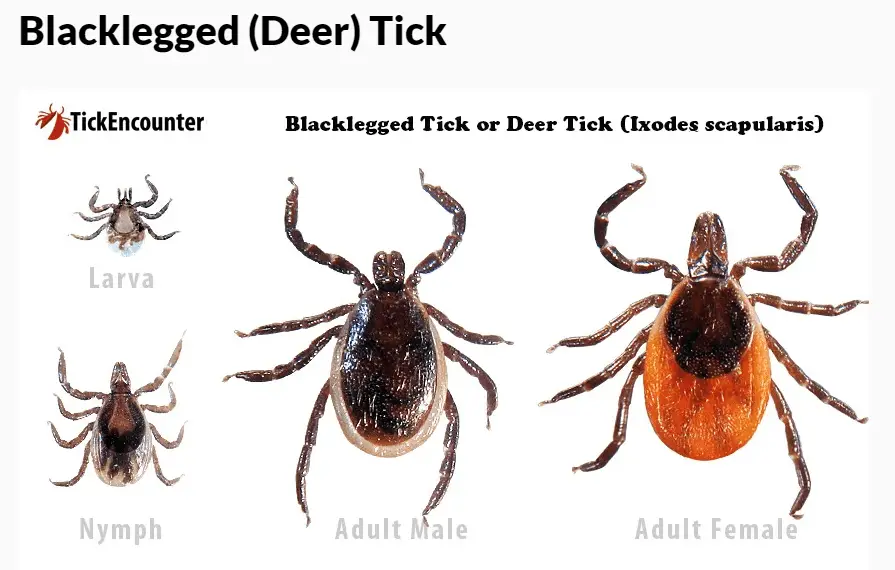
The deer tick is also known as the black legged tick has black legs with a reddish-brown, orange colored body. It has a dark brown shape, that looks like a shield located between the mouth and body of the tick.
Adult ticks are most active in the spring and fall seasons. Deer ticks are found in wooded areas in Northeastern United States and in the Midwest.
Specifically, they like habitat that is suitable for birds, mice, deer, squirrels, livestock, and coyotes.
People and dogs can encounter them in grass, brush, dead logs, and leaves.
The diseases deer ticks transmit are Lyme disease, Ehrlichia and Anaplasma. It also transmits multiple species of the deer tick virus.
American Dog Tick
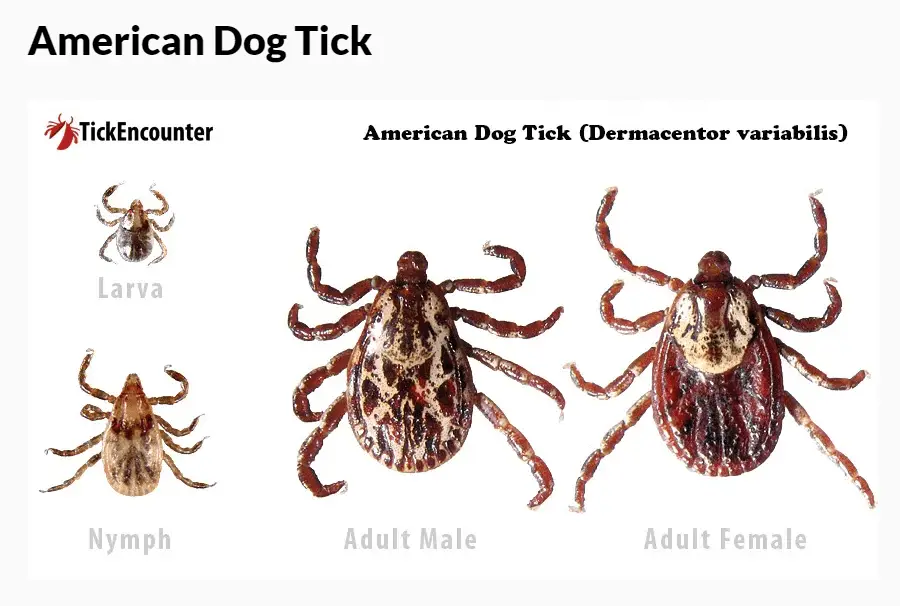
This tick can be referred to as the wood tick. It has a brown body with white spots and brown legs. The female tick has an off-white shield while the male ticks look more mottled.
They are prevalent in the Midwest, Pacific Northwest, and Eastern United States. They can be found year-round and is most active in the spring and summer. They are found in tall grassy areas and low-lying brush with little to no tree cover.
Dog ticks can transmit a serious disease called Rocky Mountain Spotted Fever.
Brown Dog Tick
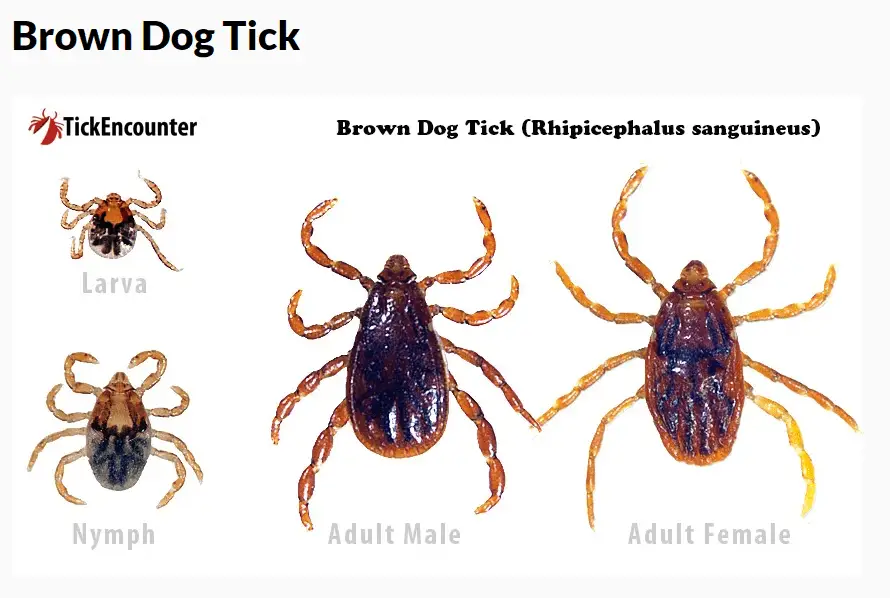
This tick can be referred to as kennel ticks. They have a reddish-brown body that is narrower than the others with brown legs. Dogs are the primarily host for this type of tick.
The reason the brown dog tick got the nickname kennel tick is due to living and breeding primarily in and around homes. They are capable of living through all life stages indoors in dog beds and indoor dog kennels.
Before it becomes a dried dead tick on dog, it can transmit diseases that are specific to canines. One serious disease is Rocky Mountain Spotted Fever.
Lone Star Tick

This tick body and legs are a reddish-brown color. The female tick has a distinguished white dot on the back known as the “lone star”.
This tick is widely spread through the eastern parts of United States but is more prevalent in the southern states.
The long star tick is known for its aggressive bite. They are abundant in the spring, summer and fall and can be found near creeks and riverbanks.
They transmit Rocky Mountain Spotted Fever, Ehrlichia, and Heartland virus. Unfortunately, dogs and humans can get bite by any of the above types of ticks.
Dead ticks can be found on dogs that regularly take oral or topical tick prevention. Most products require the ticks to bite your dog and burrow into the skin before the insecticide (tick prevention) will kill them.

Related posts:
- Ultimate Guide: How To Take Care Of A Puppy
- Ultimate Guide: How To Take Care Of A Dog
- Ultimate Guide: How To Take Care Of A Senior Dog
Dried Dead Tick on Dog: Signs and Symptoms of Tick-Borne Disease
One of the risks of walking your dog in places with tick infestations is the disease ticks transmit to the hosts. Dog owners can do their part with using tick preventatives on their dogs and checking over their dog thoroughly for ticks after outings.
Areas on your dog to give a good look over are the paws, especially between the toes, belly area, on and in the ears, nostril area, and in and around the mouth. Even despite taking all the precautions, owners still find a dried dead tick on their dogs.
After removing the dried dead tick on dog, mark your calendar, and be conscientious of the signs and symptoms.
Signs and Symptoms of Tick-Borne Disease
After you remove a dead dried tick from your dog, be aware of the following symptoms of tick-borne disease.
- Joint pain
- Depression
- Lameness
- Vomiting
- Lethargy
- Diarrhea
- Decreased appetite
- Bruising
- Fever
- Neurological problems
- Swollen lymph nodes
- Seizures
- Swelling of the limbs
If your dog is experiencing any of the signs and symptoms listed, it is a good idea to make an appointment with your veterinarian. Two common tests both require a small amount of blood to test for diseases. One is the SNAP test to specifically diagnose Lyme disease. Another test is the 4Dx text which detects Lyme disease, heartworm, Ehrlichia, and anaplasmosis.
Dried Dead Ticks: Common Tick Born Disease
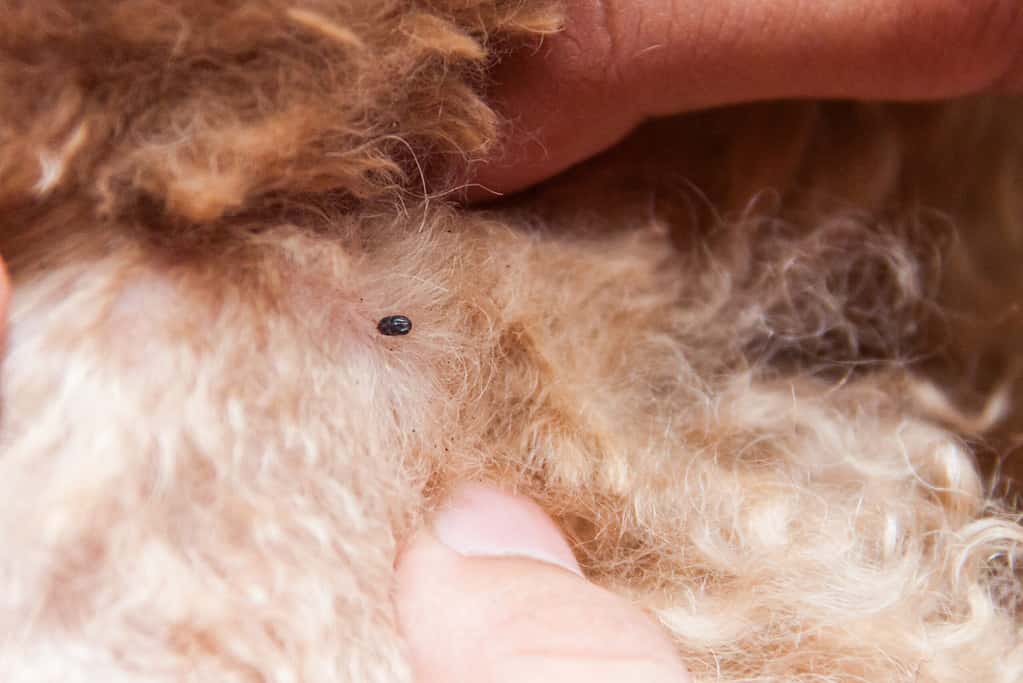
Thousands of canines each year are affected by tick-borne diseases. Symptoms can range from none to very serious. These little parasites can transmit disease in the form of an organism into your pet with one bite.
The severity of the disease can really depend on the dog’s immune system. The organism released by an infected tick invades your dog’s cells and will try to take over their immune system. Your location can determine what kinds of tick-borne diseases are in the area. There are seven common diseases found in the eastern states.
1. Lyme Disease. This infectious disease is caused by the spirochete bacteria carried by the deer tick, or Black-Legged Tick. The tick must be attached to the dog for 36-48 hours to transmit the bacteria. It can take 2-5 months before the dog shows signs and symptoms. Unlike humans, dogs do not show the symptom of erythema migrans, which is the bullseye rash that is a typical indicator for humans.
2. Canine Bortonellosis. A lesser-known tick-borne disease, however it should be treated right away. Symptoms include fever and lameness. It can be serious without adequate treatment.
3. Rickettsial Disease. This disease is primarily seen in the southeastern part of the country and transmitted from the American Dog Tick. Early treatment is crucial.
4. Rocky Mountain Spotted Fever. A common tick related disease that is carried by the American Dog Tick and Rocky Mountain Wood Tick. Dogs that are diagnosed early and treated with a round of antibiotics see significant improvement in their health.
5. Canine Ehrlichiosis. Three types of ticks can transmit this illness: the Brown Dog Tick, Lone Star Tick, and American Dog Tick. Your dog can show signs of infections 1-3 weeks after being bit by the infected tick. Dogs that are diagnosed right away can be effectively treated.
6. Anaplasmosis. The deer tick or Black Legged Tick can transfer this disease. This is a worldwide disease that has two different disease species.
7. Protozoal Disease. Ticks transmit Protozoal intracellar parasites, primarily the American Dog Ticks. Two protozoal diseases are canine babesiosis and canine hepatozoonisis. The key with any tick-borne disease is early diagnosis and treatment. Dogs with healthier immune system may show no signs of Lyme disease and other disease listed. If you live in an area that has tick infestations, it is advised to have your dog annually tested for tick-borne diseases.
Safety Tips for Removing a Tick from a Dog
When you notice your canine companion itching frequently it is time for a thorough coat check. Live ticks irritate a dog’s skin and can cause them to scratch, itch and bite the affected area.
Itching can be caused by a variety of reasons, so don’t panic. Just feel around your dog gently petting and splitting their fur with your fingers.
If you don’t find any ticks, you may find irritated or flaky skin. In that case, check out our article on the best shampoos for itchy skin.
Once you noticed a small, unusual lump on your dog, part the fur and confirm that it is a tick. Removing a dried dead tick on dog is similar to removing a live tick. In this case, you will notice the body and legs are not moving but the mouthparts will be embedded.
Engorged ticks can appear silvery-white, grey, pale pink, red or gray greenish.

There are several ways you can remove a dried dead tick on dog, however the best way and one of the most effective is with a quality pair of fine-point tweezers but if you don’t have these, a regular pair of tweezers will still work.
When hiking or walking through tick infested areas, it is a wise idea to purchase two pairs of tweezers; one you keep at home and the other in your travel bag.
Other tools are a tick removal tool kit made specifically for dog owners. If you have someone to assist with removing the dried dead tick that would be helpful but not necessary. Ticks can be removed by one person.
1. First thing, gather your supplies. It is easier when you chose a dog bed or area that your dog finds comfortable.
2. Part the fur around the dried dead tick and place the tweezers around the tick, as close to the dog’s skin as possible.
3. Once you have the tick with the tweezers, gently pull upward, apply light pressure if needed.
4. Continue to pull upward until the mouthparts are released from the dog’s skin. Avoid twisting the tweezers as you pull up.
5. Save the tick for identification purposes. A dried dead tick can be placed in a plastic bag, glass jar with lid, or stuck with a straight pin and placed in piece of foam. If you are unsure of the type of tick, bring it with you to your veterinarian.
6. Gently clean the bite area with rubbing isopropyl alcohol.
7. Once the dried dead tick on dog is removed, clean the tweezers or tick removal tool with isopropyl alcohol.
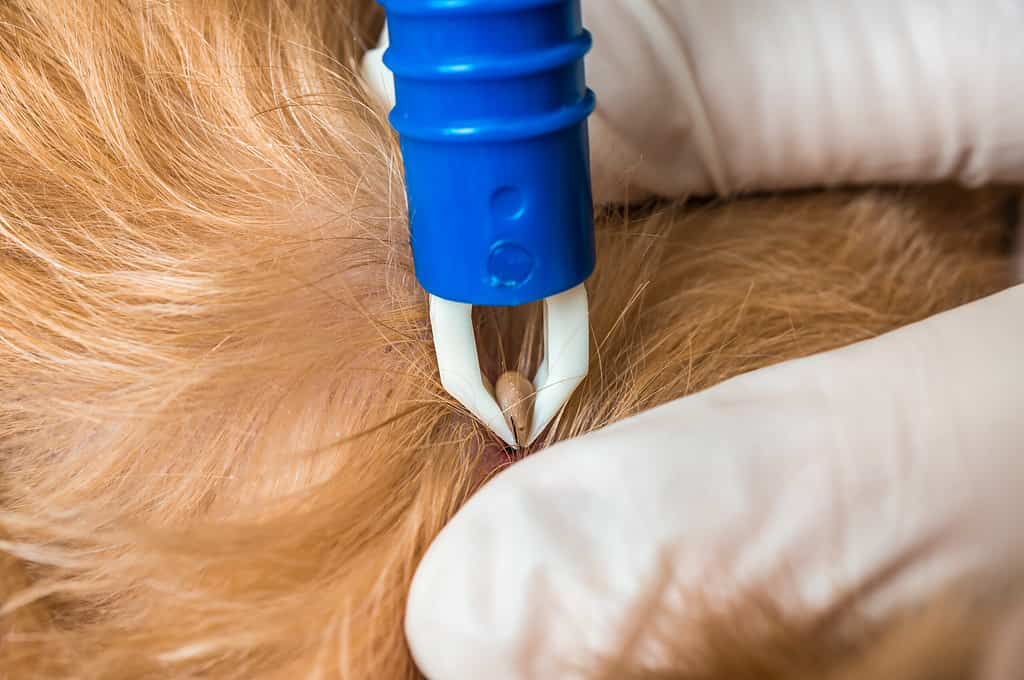
Extra tips to remember when removing tick:
- Always reach for the fine-point tweezers and avoid using soap, petroleum jelly, heat from matches, chemicals, lotion, or nail polish. Many of these solutions only make the body of the tick hard to grasp. Suffocating the tick is an old ineffective remedy.
- Do not squeeze the engorged body, as rupturing it can spread the infectious bacteria into your dog’s bloodstream.
- Pull straight up and avoid side to side motions once you have the dried dead tick. A jerking motion can detach the mouthparts and leave them in the dog’s skin.
- Removing a dried dead tick is just as dangerous as removing a live one, so take the above precautions.
- Always cleanse the bite area with a soft cotton pad and 70% isopropyl alcohol or warm soapy water.
Dogs that had a dead flat tick or engorged tick removed may still be itching in the bite area. Your pet’s skin may also be red and swollen depending on their reaction and type of tick.
Look for over the counter anti-itch medications that are safe to use on dogs. The bite area might be irritated for one to two days following the removal of the dried dead tick on dog; however, this is not a sign that your dog has disease.
Dog owners that explore or walk outside in areas with potential ticks will take the necessary precautions.
There are many flea and tick prevention products available, including:
- Topical medications- Revolution Topical Solution for Dogs (Choose the collar that fits the weight of your dog)
- Shampoos- Adams Plus Flea & Tick Shampoo with Precor
- Collars – Seresto Flea & Tick Collar for Dogs (Choose the collar that fits the size of your dog)
- Sprays – Vet’s Best Flea and Tick Home Spray
Ticks are repelled by certain smells. They do not like the smell of orange, cinnamon, lemon, peppermint, lavender and rose geranium. One natural insecticide that is effective is neem oil.
Another is cedar oil, as it kills and repels ticks by causing dehydration and inhibiting breathing. Unfortunately, there is not a single product that can be used as 100% prevention for repelling ticks.
Many outdoor enthusiasts that walk with their dogs recommend using a sticky lint roller over themselves and the dog to remove any obvious ticks, immediately after hiking.
Pet owners often use a topical spray in addition to other preventatives including oral medications. Regardless, it is always a good idea to do a careful inspection on your dog in warmer months, especially in the thick fur around their neck, hind end, and on floppy soft ears and even between their toes.

If you find a tick, remove it with fine point tweezers and clean the tick bite area. Monitor your dog in the weeks ahead.
First Aid After Removing a Dried Dead Tick on Dog
After saving the dead tick in a sealed container such as a jar or a plastic sandwich bag with a seal (just in case your veterinarian needs to see it), you will want to clean the bite area with a soft cotton pad and 70% isopropyl alcohol or warm soapy water
After cleaning the area, apply a small amount of ZYMOX Topical Cream to soothe itching, promote healing and reduce the risk of infection.
If your dog shows any signs of discomfort or inflammation, you can apply a cold compress to the affected area for 10 to 15 minutes. This will help reduce any swelling and relieve pain. You can make a cold compress by wrapping a clean cloth or towel around a bag of ice or a frozen gel pack.
It’s essential to monitor your dog’s behavior and health after removing a tick. Some signs to watch out for include lethargy, loss of appetite, and fever. These symptoms may indicate that the tick transmitted a disease, such as Lyme disease, to your dog. If you notice any of these signs, it’s crucial to contact your veterinarian immediately.
Related Posts:
FAQs on a Dried Dead Tick on Dog
Should a veterinarian exam my dog after I remove a dried dead tick on dog?
Dog owners that are unsure can give their veterinarians office a call and give details about the tick bite. As mentioned, placing the tick in a jar with a tight lid or in a sealable sandwich bag and bringing it with you can be helpful for identification.
After removing the dried dead tick, if pus or extreme redness is present near the tick bite site, make an appointment to have a veterinarian exam your dog. The bite area could get infected and need treatment.
It is common for the area around the tick bite to have mild redness, skin irritation, a small bump or scab and/or hair loss. But if the bite area doesn’t improve or your dog behavior changes then you should seek veterinary care as soon as possible.
Neither redness nor pus signifies Lyme disease, however, also as mentioned, you can choose to have a blood test done to test for disease.
Continue to monitor your dog’s health in the weeks ahead. If you see any symptoms such as fever, loss of appetite, lethargy, lameness, nose bleeds, swollen joints or swollen lymph nodes see your veterinarian immediately.
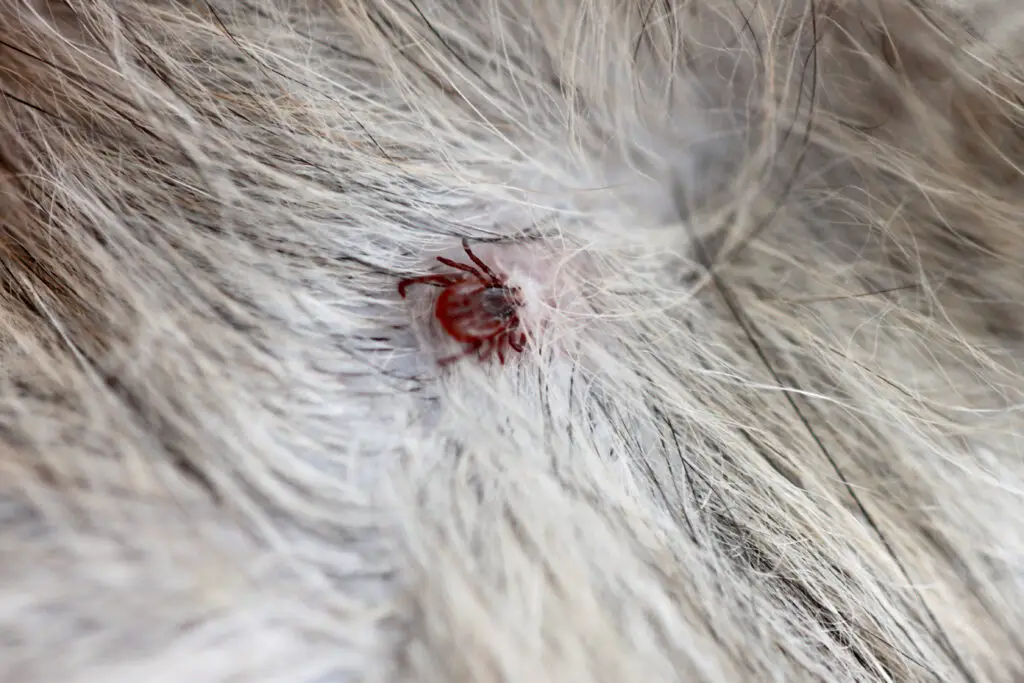
Can a tick be dead and still attached?
Yes, a tick can be dead and still attached to a host. Ticks are ectoparasites that attach themselves to their hosts and feed on their blood.
Ticks can detach from their host when they are fully engorged, or if they are disturbed or brushed off. However, if a tick dies while attached, it may remain attached to the host’s skin, even after death.
That said, there are several reasons why a tick may die while attached to a host. It could be due to natural causes such as old age or the inability to feed. Ticks can also die from exposure to harsh weather conditions, such as extreme heat or cold.
In some cases, a tick may die after being removed from the host. For example, if a tick is removed with tweezers, it may suffer damage to its mouthparts, causing it to die. However, even if the tick is dead, its mouthparts may still remain embedded in the skin, causing irritation and potential infection.
It’s important to note that a dead tick can still transmit diseases if it has already fed on the host’s blood. This is because the tick’s saliva can contain infectious agents, which can be transmitted through the bite wound.
Therefore, it’s essential to remove ticks promptly, even if they appear to be dead.
The Bottom Line on finding a Dried Dead Tick on Dog
In conclusion, being knowledgeable about tick habitat and infestations, the life cycle of ticks, how to identify common ticks, signs and symptoms of tick-borne disease, safety tips for removing a tick from a dog, and first aid after removing a dried dead tick on a dog is essential for any pet owner.
Ticks are common parasites that can be found in various environments, such as wooded areas, tall grass, and bushes.
Understanding where ticks live and their behavior can help pet owners prevent tick infestations in their pets. Pet owners should also learn to identify the different types of ticks they may encounter in their area or an area they are visiting.
Also, they should know the signs and symptoms of tick-borne diseases, such as Lyme disease, Rocky Mountain spotted fever, and ehrlichiosis.
Prevention is key to avoiding tick infestations in dogs. Owners should use tick prevention products such as collars, sprays, or topical treatments to keep ticks at bay.
Regular tick checks should be performed on dogs, especially after they have been outside in tick-infested areas. Maintaining a healthy lifestyle for dogs is also crucial to preventing tick infestations.
If a dried dead tick on dog is found, it should be removed promptly and safely to prevent disease transmission.
Safety tips for removing a tick include using gloves, tweezers, or a tick removal tool, grasping the tick as close to the skin as possible and pulling it straight out.
After removing a tick, pet owners should monitor their dogs for any signs of illness or infection and seek veterinary attention if necessary.
First aid after removing a dried dead tick on dog is also crucial. Pet owners should clean the area around the bite with antiseptic solution or soap and water, apply antiseptic cream or ointment to promote healing, and monitor their dog’s behavior and health for any signs of discomfort or inflammation.
By staying informed and prepared, pet owners can keep their pets safe from tick-borne diseases and enjoy a happy and healthy life with their furry friends.
Please read our Legal Disclaimer

